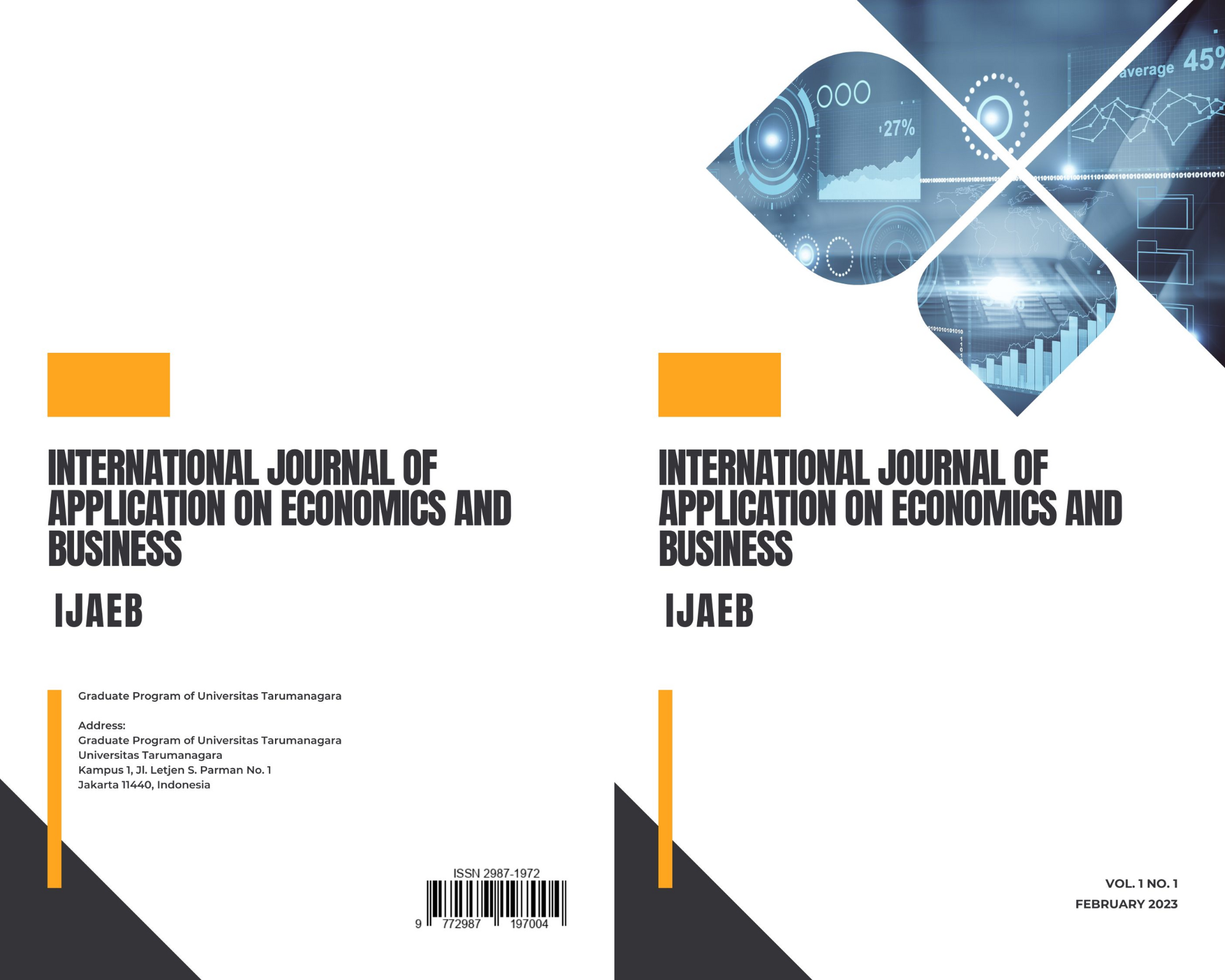Determinants of Financial Distress During COVID-19
Main Article Content
Abstract
This study aims to analyze the effect of liquidity, leverage, profitability, sales growth, and operating capacity on financial distress during the COVID-19 period. Quantitative research is used using secondary data with purposive sampling method involving 55 hotel, restaurant, tourism, and transportation companies taken from financial statement on IDX. The research methods used are multiple linear regression analysis and analyzed utilizing IBM SPSS. This study during COVID-19 carries out that leverage has an effect on financial distress, while liquidity, profitability, sales growth and operating capacity have an insignificant effect on financial distress.
Article Details

This work is licensed under a Creative Commons Attribution-NonCommercial-ShareAlike 4.0 International License.
This journal provides immediate open access to its content on the principle that making research freely available to the public supports a greater global exchange of knowledge.
IJAEB by Graduate Program of Universitas Tarumanagara is licensed under a Creative Commons Attribution-NonCommercial-ShareAlike 4.0 International License.. Permissions beyond the scope of this license may be available at https://journal.untar.ac.id/index.php/ijaeb
References
“Coronavirus,” Wikipedia, 01-Sep-2021. [Online]. Available: https://www.wikipedia.org/. [Accessed: 03-Feb-2022].
“Who director-general's opening remarks at the media briefing on COVID-19 - 11 march 2020,” World Health Organization. [Online]. Available: https://www.who.int/director-general/ speeches/detail/who-director-general-s-opening-remarks-at-the-media-briefing-on-covid-19---11-march-2020. [Accessed: 03-Sep-2021].
E. Wahyudi, “Phri: Sektor Pariwisata Rugi RP 85,7 triliun akibat pandemi,” Tempo, 03-Sep-2021. [Online]. Available: https://bisnis.tempo.co/read/1365055/phri-sektor-pariwisata-rugi-rp-857-triliun-akibat-pandemi. [Accessed: 03-Feb-2022].
A. Dirman, “Financial Distress: The Impacts of Profitability, Liquidity, Leverage, Firm Size, and Free Cash Flow,” International Journal of Business, Economics and Law, vol. 22, no. 1, pp. 17–25, 2020.
P. I. M. Susilowati, and M. R. Fadlillah, “Faktor-Faktor Yang Mempengaruhi Financial Distress Pada Perusahaan Manufaktur Di Indonesia,” Jurnal AKSI (Akuntansi Dan Sistem Informasi), vol. 4, no. 1, pp. 19–28, 2019.
A. Mappadang, S. Ilmi, W. S. Handayani, and A. Indrabudiman, “Faktor-Faktor Yang Mempengaruhi Financial Distress pada Perusahaan Transportasi,” Jurnal Riset Manajemen Dan Bisnis (JRMB) Fakultas Ekonomi UNIAT, vol. 4, no. 1, pp. 683–696, 2019.
R. T. Ariska, M. Arief, and Prasetyono, “The Effect of Gender Diversity and Financial Ratios on Financial Distress in Manufacturing Companies Indonesia,” International Journal of Economics, Business and Accounting Research (IJEBAR), vol. 5, no. 1, pp. 332–338, 2021.
Y. Yusbardini, and R. Rashid, “Prediksi Financial Distress Dengan Pendekatan Altman Pada Perusahaan Manufaktur di Indonesia,” Jurnal Muara Ilmu Ekonomi Dan Bisnis, vol. 3, no. 1, p. 122, 2019. DOI: https://doi.org/10.24912/jmieb.v3i1.3543
S. Rahmayanti, and U. Hadromi, “Analisis Financial Distress Pada Perusahaan Manufaktur Yang Terdaftar di Bursa Efek Indonesia,” Jurnal Akuntansi Dan Ekonomika,vol. 7, no. 1, pp. 53-63, 2017.
A. Zhafirah, and Majidah, “Analisis Determinan Financial Distress (Studi Empiris Pada Perusahaan Subsektor Tekstil dan Garmen Periode 2013–2017),” Jurnal Riset Akuntansi Dan Keuangan, vol. 7, no. 1, pp. 195–202, 2019.
M. A. Hidayat, and W. Meiranto, “Prediksi Financial Distress Perusahaan Manufaktur di Indonesia,” Diponegoro Journal of Accounting, vol. 3, no. 3, pp. 538-548, 2014.
M. N. Jaafar, A. A. Muhamat, S. F. S. Alwi, N. A. Karim, and S. binti A. Rahman, “Determinants of Financial Distress among the Companies Practise Note 17 Listed in Bursa Malaysia,” International Journal of Academic Research in Business and Social Sciences, vol. 8, no. 11, pp. 800–811, 2018.
T. Restianti, and L. Agustina, “The Effect of Financial Ratios on Financial Distress Conditions in Sub Industrial Sector Company,” Accounting Analysis Journal, vol. 7, no. 1, pp. 25-33, 2018. DOI: https://doi.org/10.15294/aaj.v7i1.18996
D. Yazdanfar, and P. ÖHman, “Financial distress determinants among SMEs: empirical evidence from Sweden,” Journal of Economic Studies, vol. 47, no. 3, pp. 547–560, 2020. DOI: https://doi.org/10.1108/jes-01-2019-0030
R. V. D. Giarto, and F. Fachrurrozie, “The Effect of Leverage, Sales Growth, Cash Flow on Financial Distress with Corporate Governance as a Moderating Variable,” Accounting Analysis Journal, vol. 9, no. 1, pp. 15–21, 2020. DOI: https://doi.org/10.15294/aaj.v9i1.31022.
P. A. D. W. Putri, “The Effect of Operating Cash Flows, Sales Growth, and Operating Capacity in Predicting Financial Distress,” International Journal of Innovative Science and Research Technology, vol. 6, no. 1, pp. 638–646, 2021.
R. D. Handayani, A. Widiasmara, and N. Amah, “Pengaruh Operating Capacity dan Sales Growth Terhadap Financial Distress Dengan Profitabilitas Sebagai Variabel Moderating,” Seminar Inovasi Manajemen, Bisnis Dan Akuntansi I, pp. 137–151, 2019.
D. S. Saleh, “Pengaruh Operating Capacity, Arus Kas Operasi dan Biaya Variabel Terhadap Financial Distress pada Perusahaan Manufaktur Subsektor Textil dan Garment yang Terdaftar di Bursa Efek Indonesia (BEI) Tahun 2009–2016,” Eqien: Jurnal Ekonomi Dan Bisnis, vol. 8, no. 1, pp. 34–49, 2018. DOI: https://doi.org/10.34308/eqien.v5i1.12
M. Spence, Job market signaling, The Quarterly Journal of Economics, vol. 87, no. 3, pp. 355-374, 1973.
S. A. Ross, “The determination of financial structure: The incentive-signalling approach,” The Bell Journal of Economics, vol. 8, no. 1, pp. 23–40, 1977. DOI: https://doi.org/10.2307/ 3003485
W. Setyowati, and N. R. N. Sari, “Pengaruh Likuiditas, Operating Capacity, Ukuran Perusahaan dan Pertumbuhan Penjualan Terhadap Financial Distress (Studi ada Perusahaan Manufaktur yang Terdaftar di BEI Tahun 2016–2017),” Jurnal Magisma, vol. 7, no. 2, pp. 135–146, 2019.
O. Kusanti, “Pengaruh Good Corporate Governance dan Rasio Keuangan Terhadap Financial Distress,” Jurnal Ilmu & Riset Akuntansi, vol. 4, no. 10, pp. 1–21, 2015.
V. Diyanto, The Effect of Liquidity, Leverage and Profitability on Financial Distress. Indonesian Journal of Economics, Social, and Humanities, vol. 2, no. 2, pp. 127-133, 2020. DOI: https:// doi.org/10.31258/ijesh.2.2.127-133
D. E. Kieso, J. J. Weygandt, and T. D. Warfield, Intermediate Accounting: IFRS Edition, 4th ed. Reading, Hoboken, NJ: Wiley, 2020.



